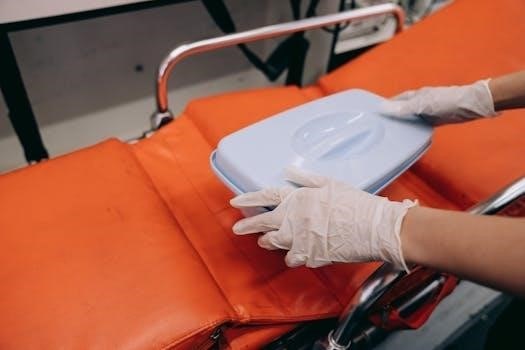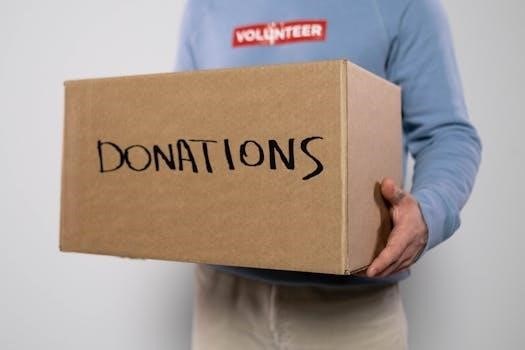First Aid Box Checklist PDF⁚ A Comprehensive Guide
This comprehensive guide, dated 02/09/2025, provides a detailed overview of essential first aid kit checklists. It emphasizes the importance of adhering to standards such as OSHA guidelines. Regular maintenance, replenishment, and proper location are crucial for effective emergency response in various settings.
First aid kit checklists are vital tools for ensuring preparedness in various environments, from homes to workplaces. These checklists serve as a systematic way to verify that all necessary supplies are present, unexpired, and readily available for use in case of an emergency. A well-organized checklist helps in maintaining a fully stocked kit, capable of addressing a range of injuries and medical situations.
The concept of a first aid kit checklist extends beyond simply listing items; it involves understanding the specific needs of the environment where the kit is located. For instance, a workplace first aid kit might require additional items based on the industry’s inherent risks, as dictated by OSHA or CSA Z1220-17 standards. Regularly reviewing and updating the checklist ensures compliance and optimizes the kit’s effectiveness in providing timely assistance.
Importance of a Regularly Updated Checklist
A regularly updated first aid kit checklist is paramount for ensuring the effectiveness of your first aid resources. Over time, supplies can expire, become damaged, or be used without being replaced. An outdated checklist can lead to a false sense of security, leaving individuals unprepared when an actual emergency arises. Consistent review and updates guarantee that the kit contains viable and necessary items, aligning with current needs.
Regular updates also allow for adjustments based on changing circumstances or risk assessments. For instance, new workplace hazards might necessitate the addition of specific items. Furthermore, staying current with best practices and guidelines, such as those from OSHA or the Health & Safety Authority, ensures that your kit meets the latest standards. This proactive approach maximizes the kit’s utility and enhances its ability to address a wide range of medical situations effectively.
Essential Components of a First Aid Kit Checklist

A comprehensive first aid kit checklist should encompass several essential categories to ensure preparedness for various medical situations. This includes basic first aid supplies, wound care items, and a section for medications and ointments, each requiring careful consideration. Essential components typically begin with items like adhesive bandages of multiple sizes, sterile gauze pads, and non-latex disposable gloves to minimize allergic reactions and maintain hygiene.
Wound care is another critical area. Antiseptic wipes, cleansing agents, and various sizes of dressings are necessary for treating cuts, abrasions, and burns. The checklist should also include tools like tweezers for removing splinters, scissors for cutting bandages, and medical tape for securing dressings. Medications and ointments, such as antibiotic ointment, should be considered, though their inclusion depends on a risk assessment. A well-structured checklist ensures all these elements are readily available and properly maintained.
Basic First Aid Supplies

The foundation of any first aid kit lies in its basic supplies, crucial for addressing immediate and minor injuries. This section of the checklist should prioritize items like adhesive bandages, available in assorted sizes to cover various wounds effectively. Sterile gauze pads are essential for cleaning and covering wounds, preventing infection. Non-latex gloves are a must-have to ensure hygiene and prevent allergic reactions for both the caregiver and the injured person.
Other fundamental supplies include antiseptic wipes for cleaning wounds, a CPR mask for safe rescue breathing, and medical tape for securing bandages. A first aid guide is also invaluable, providing step-by-step instructions for various emergencies. Furthermore, consider including items such as a pocket mask for CPR, a medical log book for documenting incidents, and a pen and notepad for recording vital information during emergency situations. Regular inspection ensures all these basic supplies are present and in good condition.
Wound Care Items
Effective wound care is paramount in a first aid response, and a well-stocked kit should include a comprehensive selection of wound care items. Sterile saline solution is essential for irrigating wounds, removing debris, and reducing the risk of infection. A variety of non-stick wound dressings, including different sizes, are critical for protecting wounds while promoting healing. Adhesive strips, such as Band-Aids, in multiple sizes, are necessary for covering minor cuts and abrasions.
Combine pads and eye pads are crucial for managing larger wounds and eye injuries. Gauze swabs are valuable for cleaning wounds and applying antiseptic solutions. Triangular bandages are versatile and can be used as slings, tourniquets, or for securing dressings. Consider including items like steri strips for closing small wounds and moleskin for preventing blisters. Regular checks ensure these items are readily available and haven’t expired, maintaining the kit’s effectiveness in wound management.
Medications and Ointments (Considerations)
The inclusion of medications and ointments in a first aid kit requires careful consideration, often guided by a risk assessment specific to the environment. Antibiotic ointment is valuable for preventing infection in minor cuts and abrasions, while topical anti-itch lotions, such as hydrocortisone or calamine lotion, can alleviate discomfort from insect bites or minor skin irritations. Oral antihistamines like Benadryl, Zyrtec, or Claritin might be considered for allergic reactions, but their inclusion should align with workplace policies and individual health needs.
Medications should be stored according to manufacturer instructions, with regular checks for expiration dates. A medical logbook is useful for recording the use of any medications, including the patient’s name and date. It’s essential to remember that the availability and use of medications should be determined by a qualified professional or first aider, adhering to relevant guidelines and regulations. Always prioritize safety and legal compliance when deciding which medications to include.
Workplace First Aid Kit Requirements
Workplace first aid kit requirements are dictated by regulations like OSHA guidelines and standards such as CSA Z1220-17. These guidelines ensure employers provide and maintain suitably marked and easily accessible first-aid equipment. The contents of a workplace first aid kit should be determined by a thorough risk assessment to ensure the quantities and items meet the specific needs of the workplace, considering potential hazards and the number of employees.
A designated person, often a trained first aider, should be responsible for maintaining the kit. They should regularly inspect the kit to ensure all items are present, clean, and within their expiry dates. The kit must contain a list of its contents, protected from dust, moisture, and contamination. Mandatory contents typically include gloves, bandages of various sizes, sterile gauze, disposable non-latex gloves, tweezers, and scissors. Compliance with these requirements promotes a safe working environment.
OSHA Guidelines
OSHA (Occupational Safety and Health Administration) provides minimum requirements for workplace first-aid kits and supplies, ensuring employers maintain a safe working environment. While OSHA doesn’t offer a specific mandatory checklist, it emphasizes the necessity of providing adequate first aid supplies based on potential workplace hazards. Employers must assess their workplace to identify risks and determine the appropriate type and quantity of supplies needed to address potential injuries or illnesses.
These guidelines generally include essential items such as bandages, gauze pads, adhesive tape, antiseptic wipes, and gloves. The first aid kit should be easily accessible to all employees and kept in a clearly marked location. Regular inspections are crucial to ensure that supplies are replenished, and expired items are replaced promptly. Maintaining compliance with OSHA guidelines helps employers protect their employees and minimize the impact of workplace injuries.
CSA Z1220-17 Standards
CSA Z1220-17 is a comprehensive Canadian standard that outlines the minimum requirements for workplace first aid kits. This standard provides a detailed checklist of essential items to include in a first aid kit, ensuring that workplaces are adequately prepared to handle various types of injuries and medical emergencies. The CSA Z1220-17 standard covers aspects like kit contents, quantities, and maintenance protocols.
The checklist includes items such as bandages of multiple sizes, sterile gauze pads, non-latex gloves, antiseptic wipes, scissors, and tweezers. It also emphasizes the importance of regular inspections and restocking to ensure that the kit remains complete and up-to-date. Adhering to CSA Z1220-17 standards helps organizations create a safe and healthy work environment, reduce the risk of workplace injuries, and comply with regulatory requirements. This standard provides a structured approach to first aid preparedness, promoting employee well-being and minimizing potential liabilities.
Maintaining and Replenishing Your First Aid Kit
Maintaining and replenishing your first aid kit is crucial for ensuring its effectiveness during emergencies. Regular inspections are necessary to verify that all items are present, clean, and in usable condition. Establish a schedule, such as monthly or quarterly checks, to systematically review the kit’s contents. These inspections should include verifying the expiration dates of medications and other time-sensitive items, promptly replacing anything that has expired to ensure efficacy.
A designated person, ideally a trained first aider, should be responsible for this task. Documenting each inspection with a checklist helps track inventory and identify items that need restocking. After each use, immediately replenish any supplies that were consumed. Store the first aid kit in a readily accessible location, protected from dust, moisture, and extreme temperatures. Proper maintenance and timely replenishment will ensure your first aid kit is always ready to provide essential care when needed, enhancing workplace safety.
Regular Inspection Schedule
Establishing a regular inspection schedule is paramount for maintaining a well-stocked and functional first aid kit. Implementing a consistent schedule, such as monthly or quarterly checks, ensures that the kit remains prepared for any emergency. During each inspection, meticulously review the contents against a checklist to confirm the presence of all essential items and their usability. This process involves verifying that bandages, antiseptic wipes, gloves, and other supplies are available in sufficient quantities.
Furthermore, the inspection should include a thorough assessment of the condition of each item. Ensure that packaging remains intact, and that items are free from contamination or damage. Record the date of each inspection and any actions taken, such as restocking or replacing expired items, in a logbook or electronic document. This documentation provides a clear audit trail of the kit’s maintenance history and facilitates continuous improvement of the first aid program. A diligent inspection schedule is key to maintaining readiness and promoting a safe environment.
Expiration Date Management
Effective expiration date management is a critical aspect of maintaining a reliable first aid kit. Medications, antiseptic solutions, and certain dressings have expiration dates, after which their effectiveness diminishes. Regularly reviewing these dates and promptly replacing expired items is essential to ensure the kit’s readiness. Create a system for tracking expiration dates, such as a spreadsheet or a label on each item. Schedule regular checks, ideally coinciding with the overall kit inspection, to identify items nearing or past their expiration.
When replacing expired items, dispose of them properly according to local regulations. Consider using a color-coding system to visually identify items with upcoming expiration dates, allowing for proactive replacement. Educate first aid personnel about the importance of expiration dates and the potential risks of using expired supplies. Integrating expiration date management into the regular inspection schedule streamlines the process and minimizes the likelihood of encountering unusable items during an emergency. Proactive expiration date management is a cornerstone of responsible first aid kit maintenance.
First Aid Kit Location and Accessibility
The strategic location and easy accessibility of first aid kits are paramount for effective emergency response. Kits should be placed in prominent, easily reachable locations known to all personnel. Consider high-traffic areas, points of potential hazards, and areas with frequent incidents. Ensure the location is well-lit and free from obstructions, allowing quick access even in stressful situations. The kits should be clearly marked with recognizable symbols, such as a white cross on a green background, to facilitate immediate identification.
Multiple kits may be necessary for larger workplaces or those with diverse operational areas. Regularly communicate the location of first aid kits during safety briefings and training sessions. Conduct periodic drills to test accessibility and familiarize personnel with retrieval procedures. Designate responsible individuals to ensure that kits remain accessible and that pathways to them are kept clear. The accessibility of a first aid kit directly impacts the speed and effectiveness of initial response, potentially mitigating the severity of injuries and improving outcomes. A readily accessible kit is a vital component of a comprehensive safety plan.

Customizing Your Checklist Based on Risk Assessment
A standardized first aid kit checklist provides a foundation, but tailoring it to specific workplace hazards and potential injuries is crucial. A thorough risk assessment identifies potential dangers, allowing for the inclusion of specialized items. For example, workplaces with chemical exposure risks should include eye wash solutions and burn creams. Construction sites might require additional splints and wound closure strips. Food handling environments necessitate more antiseptic wipes and specialized dressings.

Consider the number of employees, the types of activities performed, and the proximity to medical facilities. Consultation with occupational health professionals can provide valuable insights into customizing the checklist. Document the risk assessment process and the rationale behind additions or modifications to the standard checklist. Review and update the customized checklist regularly, particularly after any changes in work processes or the introduction of new equipment. This proactive approach ensures the first aid kit is equipped to address the unique needs of the specific environment, enhancing preparedness and improving response effectiveness. Customize to protect!
